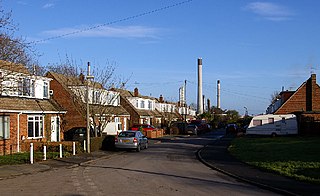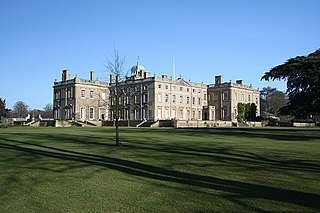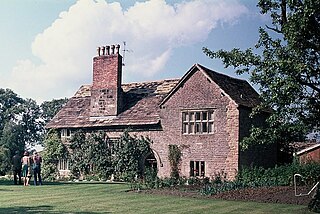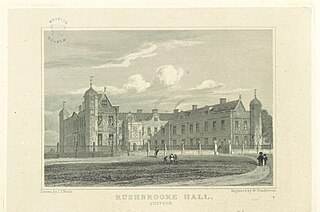
Eaton Bray is a village and civil parish in Bedfordshire, England. It is situated about three miles south-west of the town of Dunstable and is part of a semi-rural area which extends into the parish of Edlesborough. In the 2011 United Kingdom census the population of the parish was recorded as 2,585.

Baddesley Clinton is a moated manor house, about 8 miles (13 km) north-west of the town of Warwick, in the village of Baddesley Clinton, Warwickshire, England. The house probably originated in the 13th century, when large areas of the Forest of Arden were cleared for farmland. The site is a Scheduled Ancient Monument and the house is a Grade I listed building. The house, park and gardens are owned by the National Trust and open to the public; they lie in a civil parish of the same name.

Baconsthorpe Castle, historically known as Baconsthorpe Hall, is a ruined, fortified manor house near the village of Baconsthorpe, Norfolk, England. It was established in the 15th century on the site of a former manor hall, probably by John Heydon I and his father, William. John was an ambitious lawyer with many enemies and built a tall, fortified house, but his descendants became wealthy sheep farmers, and being less worried about attack, developed the property into a more elegant, courtyard house, complete with a nearby deer park.

North Killingholme is a small village and civil parish in North Lincolnshire, England.

Abbots Ripton is a village and civil parish in Cambridgeshire, England. Abbots Ripton is situated within Huntingdonshire which is a non-metropolitan district of Cambridgeshire as well as being an historic county of England. Abbots Ripton lies approximately 4 miles (6 km) north of Huntingdon on the B1090.

Helmingham Hall is a moated manor house in Helmingham, Suffolk, England. It was begun by John Tollemache in 1480 and has been owned by the Tollemache family ever since. The house is built around a courtyard in typical late medieval/Tudor style. The house is listed Grade I on the National Heritage List for England, and its park and formal gardens are also Grade I listed on the Register of Historic Parks and Gardens.

Culford Park in Culford, Suffolk, England, is a country house that is the former seat of the Bacon, Cornwallis and Cadogan families, and now it is the home of Culford School.

Sandon is a village in the civil parish of Sandon and Burston, in the Stafford district, in the county of Staffordshire, England. It is about 4.5 miles (7 km) northeast of Stafford. The village is in the Trent Valley on the A51 road. On 6 September 1989 the parish was renamed from "Sandon" to "Sandon & Burston".

Chorley Old Hall is a moated manor house on the B5359 road to the southwest of Alderley Edge, Cheshire, England. The house is recorded in the National Heritage List for England as a designated Grade I listed building, and the moated site is a scheduled monument. It is the oldest inhabited country house in Cheshire and consists of two ranges, one medieval and the other Elizabethan.

Yeaveley Preceptory, also known as Stydd Preceptory, was a preceptory of the Knights Hospitaller, near the village of Yeaveley, in Derbyshire, England. It was around a mile west of the village, on the site of the current Stydd Hall. The Preceptory has been variously known as "Yeaveley Preceptory", "Yeaveley Bailiwick", "Yeaveley and Barrow Preceptory" and "Stydd Preceptory".

Morleys Hall, a moated hall converted to two houses, is situated at grid reference SJ 689 992 on Morleys Lane, on the edge of Astley Moss in Astley in the historic county of Lancashire and the ceremonial county of Greater Manchester, England. It was largely rebuilt in the 19th century on the site of a medieval timber house. The hall is a Grade II* listed building and the moat a scheduled ancient monument. Morleys is a private residence.

Holford Hall is a country house west of the village of Plumley, Cheshire, England. It consists of a fragment of a much larger timber-framed house, built in 1601 for Mary Cholmondeley on a moated site. Part of the building was demolished in the 1880s. The house is timber-framed with rendered infill. It has a stone-slate roof. The entrance front has two bays with gables and Ionic pilasters. The architectural historian Nikolaus Pevsner describes this front as being "highly decorated". The house is recorded in the National Heritage List for England as a designated Grade II* listed building. The stone bridge leading to the house across the moat is listed at Grade II, and the moated site on which the house stands is a scheduled monument.

Hulme Hall is a house on a moated site in the parish of Allostock, Cheshire, England. It originated in the 15th century, with additions and alterations in the 17th and 19th centuries. It is now a farmhouse. The house is constructed in brown brick, and has a roof of stone-slate and Welsh slate. It is in two storeys with an attic, and has an asymmetrical plan. The northeast front is the entrance front, and has three gabled bays. The garden front is on the northwest; it has five bays, two of which are stepped back in two stages. Most of the windows are two or three-light casements. The house is recorded in the National Heritage List for England as a designated Grade II* listed building. The bridge over the moat leading to the house is also listed at Grade II*. The moated site on which the house stands is a scheduled monument. It had been the home of the Grosvenor and Shakerley families, both of whom were prominent in Cheshire.

Lower Huxley Hall is a moated manor house in Cheshire, England, located about 6.5 miles (10 km) southeast of Chester. It lies roughly halfway between the villages of Huxley and Hargrave, It dates from the late 15th century, with major additions and alterations in the 17th century. A small addition was made to the rear in the 19th century. It was originally a courtyard house, but only two wings remain. The house is designated by English Heritage as a Grade II* listed building.
Lymm Hall is a moated country house in the village suburb of Lymm in Warrington, Cheshire, England. It is recorded in the National Heritage List for England as a designated Grade II* listed building.
Thornhill Hall is a ruined medieval manor house on a moated island located in Rectory Park, Thornhill, West Yorkshire, England. The ruins are listed as grade II. and the moat, with the surrounding grounds, is a scheduled monument.

The ruin of Tabley Old Hall is on an island surrounded by a moat in the civil parish of Tabley Inferior, about 1.5 miles (2.4 km) to the west of Knutsford, Cheshire, England. The ruin is recorded in the National Heritage List for England as a designated Grade II* listed building, and the moated site on which it stands is a scheduled monument.

Rushbrooke Hall was a British stately home in Rushbrooke, Suffolk. For several hundred years it was the family seat of the Jermyn family. It was demolished in 1961.

Playford Hall is a country house in the civil parish of Playford, in the East Suffolk district, in the county of Suffolk, England. Playford Hall is set in 30 acres, the gardens were designed in 1960 by Lady Penelope Aitken. Playford Hall is owned and occupied by the Melrose family and the grounds are sometimes opened to support charities. The house is a Grade II* listed building and the moated site is a scheduled monument.


















